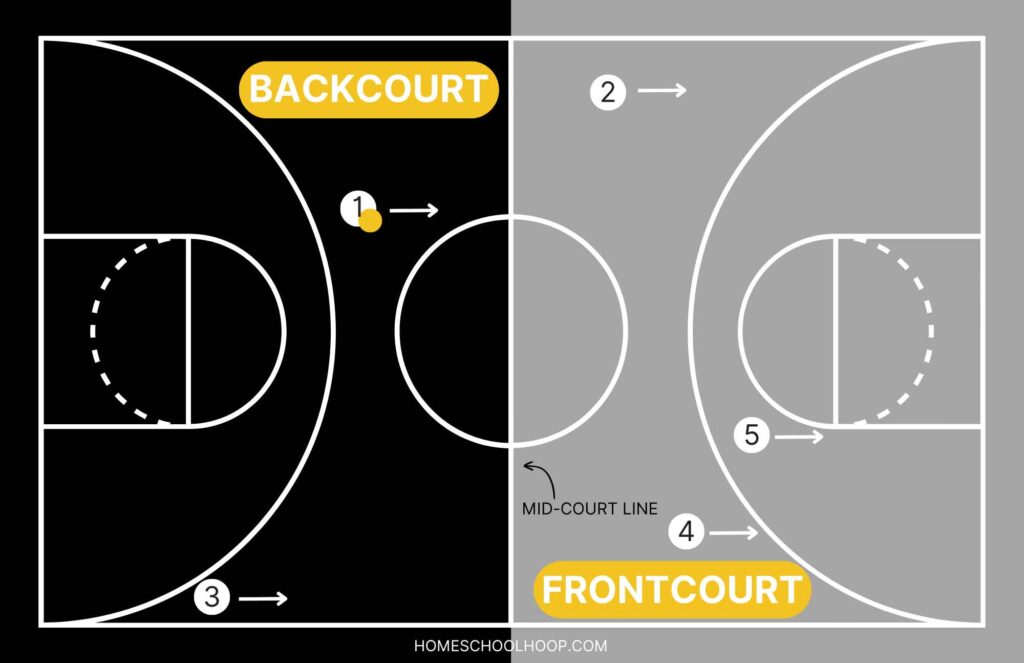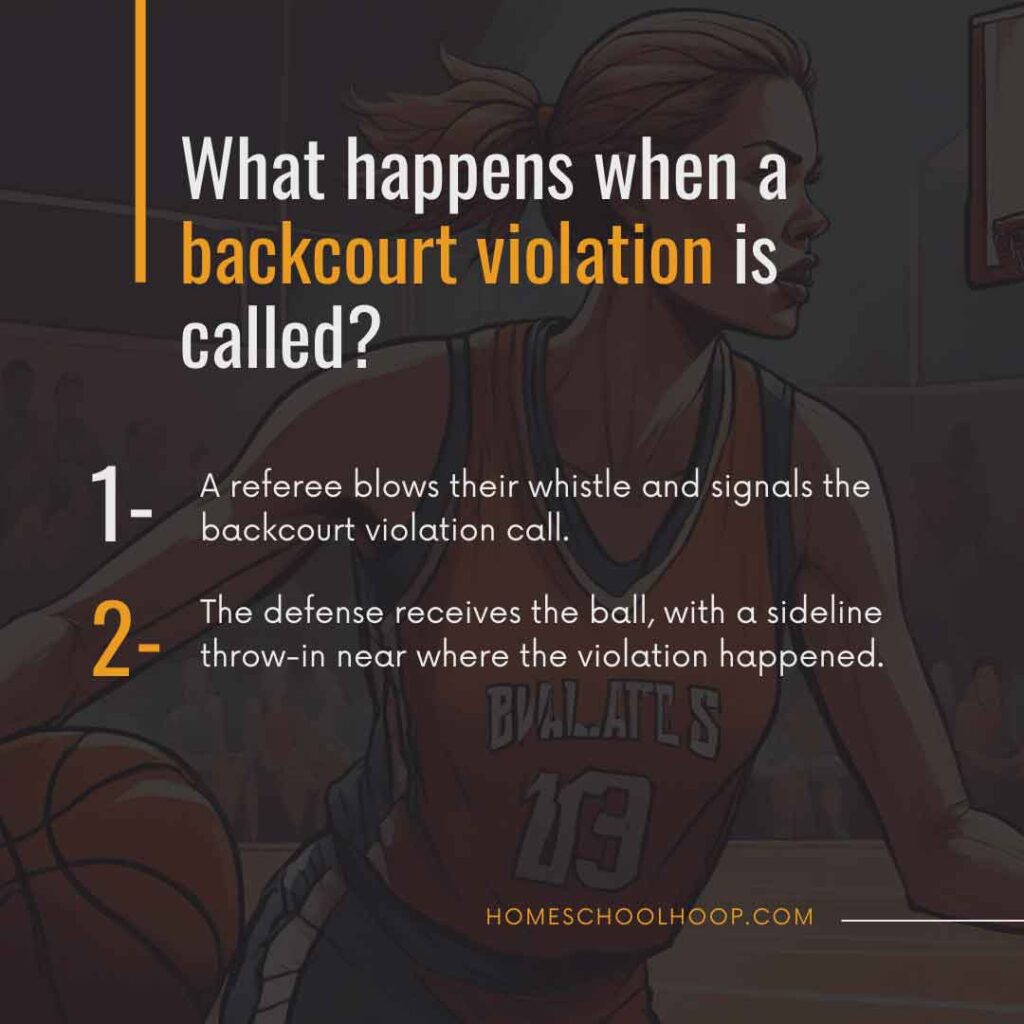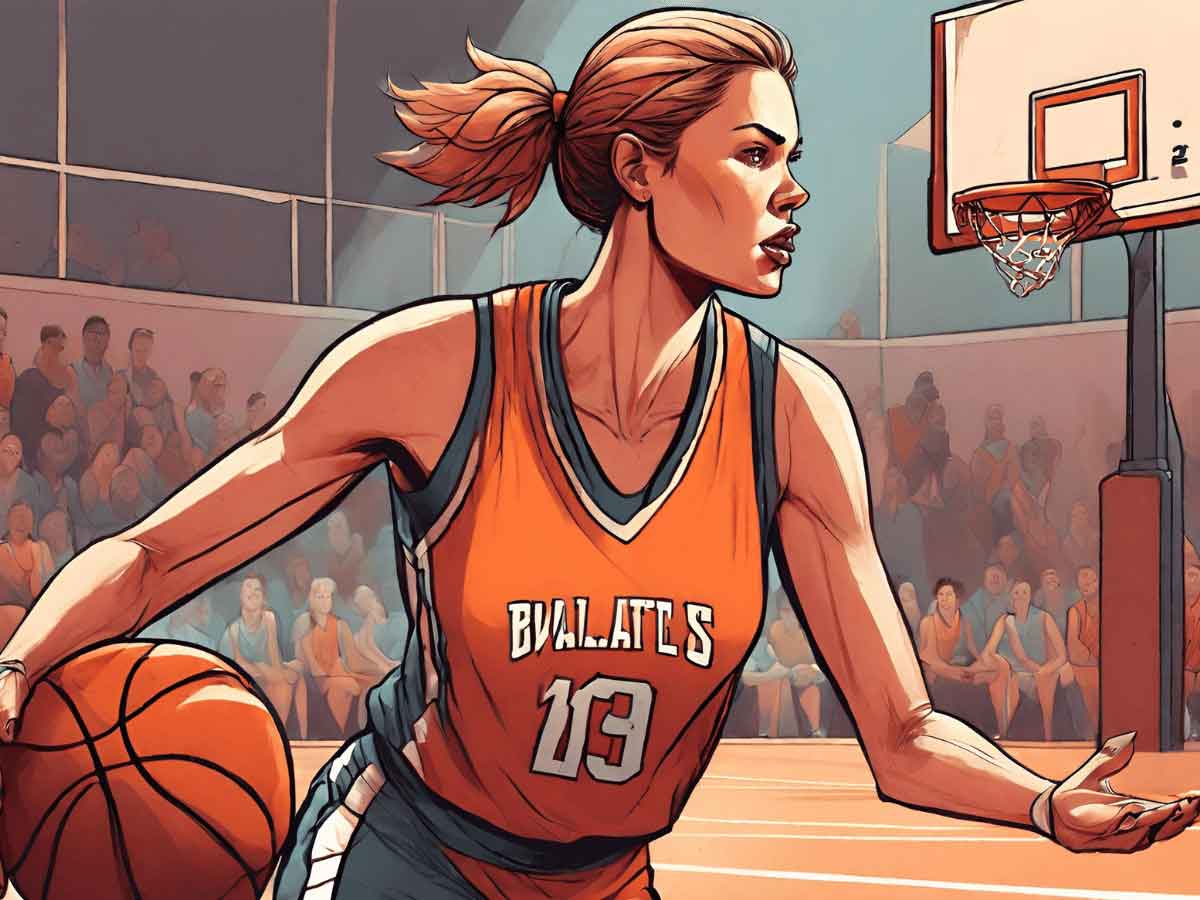Some basketball rules exist because they keep the game fast-paced and exciting. That is the case with the backcourt violation. This rule, which now plays a big role in offensive and defensive strategies, dictates how the offense can move the ball across the court.
Key Takeaways:
- There are two types of backcourt violations: when the offensive team fails to bring the ball over the mid-court line quickly enough or when they mistakenly send the ball back into their own backcourt.
- The rule puts pressure on the offense and gives the defense more opportunities to force turnovers.
- The specifics of a backcourt violation vary depending on which basketball league you’re watching or playing in.
Here, we’ll dive into the basics of basketball backcourt violations. You’ll learn how the rule works, the impact it has on the game, and tips for players to steer clear of them.
Understanding Backcourt Violations
Getting a grip on backcourt violations is crucial to keeping the ball in your court – literally. These timed rules determine how and when the offense must move the ball across the court.
What is a Backcourt Violation?
Put simply, a backcourt violation in basketball can happen in two ways:
- 8 or 10-Second Violation: This happens if the team with the ball doesn’t get it over the mid-court line into the frontcourt within the set time—either 8 or 10 seconds, depending on the league.
- Over and Back Violation: If the ball, after making it into the frontcourt, is then passed or dribbled back into the backcourt by the offense, that’s a violation.

Differences by League
While the core idea and purpose of the backcourt violation remain the same – to prevent stalling and encourage offensive progression – the specifics can differ slightly by league. Here’s a brief overview:
NBA and WNBA:
- Prioritizing a fast-paced game, the professionals use an 8-second rule for getting the ball over mid-court.
- The over-and-back rule applies once the ball and the player’s both feet have fully crossed into the frontcourt.
NCAA Men’s and Women’s Basketball:
- Have a 10-second rule for advancing the ball across the mid-court line.
- Similar to the NBA/WNBA, sending the ball back to the backcourt after it’s been in the frontcourt is a violation.
FIBA (International Basketball):
- Uses an 8-second rule like the NBA and WNBA.
- The criteria for an over-and-back violation align with those set by the NBA/WNBA.
Exceptions to the Rule
Not every move back across the mid-court line is a violation. There are backcourt violation exceptions that keep the game interesting.
Over and Back Exception:
If a defensive player tips or deflects the ball back into the backcourt, the offense can recover it without penalty.
This can happen during an interception attempt or when a player tips the ball away from the ball-handler.
8 or 10-Second Rule Reset:
If the defense commits a foul in the backcourt, the 8 or 10-second clock resets.
Picture a defender applying full-court pressure illegally touching the ball-handler and getting called for hand-checking. This resets the count and gives the offensive team another full duration to cross mid-court.
What is the Penalty for a Backcourt Violation?
So, what happens if your team slips up and commits a backcourt violation? Simple–it’s an immediate turnover in basketball, and you lose possession. After the referee stops play and signals the violation, the other team gets to throw the ball in from the side where the violation happened.
As you can see, the rule presents the defense with an opportunity. It gives them a chance to regain the ball by making aggressive defensive plays in the backcourt.

Common Backcourt Violation Examples
Backcourt violations can catch even the most experienced teams off guard. Let’s break down some typical situations where violations are called, making it simpler to understand.
8 or 10-Second Violation Scenarios
- When the Pressure’s On: Imagine the defense is giving it their all with a full-court press, denying passes and pressuring the ball. If the offense doesn’t get the ball over the mid-court line within the required 8 or 10 seconds, that’s a classic case leading to a violation.
Over and Back Violation Scenarios
- The Errant Pass: Picture this: a player who’s made it to the frontcourt tries to pass back to a teammate who hasn’t crossed the line yet, or who accidentally steps back over the line while catching the ball. This is a no-go and counts as a violation.
- Oops, Lost the Ball: Now, imagine a player in the frontcourt who accidentally fumbles the ball, sending it rolling back into their own half. If they or a teammate touches it first in the backcourt, that’s another violation.
- Dribbling or Pivot Foot Error: Here’s a player who’s just made it to the frontcourt, but then, maybe out of confusion or a misstep, ends up dribbling or stepping back over the mid-court line. Whether they’re pressured by the defense or not, this move will cost them possession.
TRIVIA: YES OR NO?
Is the following scenario a backcourt violation?
Off a missed shot, an offensive rebounder uses one hand to save the ball from bouncing out of bounds and tries to pass the ball to a teammate. Instead, the ball flies into the backcourt and is touched first by another offensive player.
Scroll to the bottom for the answer.
Clearing Up Common Backcourt Violation Misconceptions
It’s easy to get caught up in the heat of the game and think a backcourt violation has been missed by the refs, especially when the crowd, coaches, and sometimes players get vocal about it. A lot of the confusion comes from widespread misconceptions about what actually constitutes a violation. Let’s set the record straight on a few points:
A sideline inbounds pass can be thrown into the backcourt without it being a violation. Throwing the ball into the backcourt during a sideline inbound is perfectly fine, even if the player making the inbound is past the mid-court line. They can pass to a teammate in the backcourt without any penalty.
The offense can legally retrieve a missed shot that was accidentally batted back into the backcourt without it being a violation. If an offensive player tries to grab a rebound and accidentally sends the ball back into their half, it’s not a violation to retrieve it. This is because there was never full control of the ball to begin with.
An offensive player, even if they’ve already established a frontcourt position, can legally retrieve a ball deflected by a defender into the backcourt. If a defender tips or deflects the ball and it ends up in the backcourt, an offensive player who has already been in the frontcourt can go back to retrieve it. This situation does not count as a violation because the movement was initiated by a defensive action.
It’s not a backcourt violation if you dribble in the frontcourt but keep your feet in the backcourt. Full frontcourt position requires both the ball and both feet of the player to be over the line. So, if you’re still technically in the backcourt with your feet, you haven’t committed a violation.
The Impact of Backcourt Violations on the Game
Backcourt violations can be game-changers, especially in those nail-biting moments. They have the power to shift momentum, break the rhythm of an offense, and sometimes even decide the outcome of tight matchups. Both defense and offense need to strategize around this rule for their advantage.
Defensive Strategies Leveraging Backcourt Violations
Defenses love backcourt violations because they’re a chance to turn up the heat and snag the ball back. Here’s how they go about it:
- Full-Court Press: Applying full-court pressure can delay the offense’s advancement, increasing the chance of an 8 or 10-second violation. Plus, the offense knows the clock’s ticking, making rushed and often messy plays more likely.
- Trapping: Defenders can swarm and trap a ball-handler just as they cross the mid-court line, and the hope is they’ll panic and either step back over the line or throw a pass that leads to a turnover.
Offensive Strategies to Dodge Backcourt Violations
On the flip side, offenses have to be ready to counter these defensive pressures to avoid committing backcourt violations. They can do this by:
- Stay Cool, Dribble Well: Skillful dribbling and mastering the art of keeping cool under pressure are key. Players need to know the court like the back of their hand, ready to dodge traps and keep moving forward.
- Strategic Passing: Quick, accurate passes that advance the ball quickly up the court can throw off an aggressive defense.
- Internal Clock: Players need to develop a sixth sense for timing. While they’re running plays, part of their brain should be counting down, ready to move the ball before time’s up. And hey, the bench can help by keeping an eye on the clock and shouting out warnings.
- Timeouts are Lifesavers: Stuck in a bind? A well-timed timeout can give the team a moment to regroup and plan their next move without the pressure of an imminent violation.
FAQs
What is considered a backcourt violation?
A backcourt violation occurs when the offensive team fails to bring the ball over the mid-court line within the allotted time (8 or 10 seconds, depending on the league) or when the ball, having been established in the frontcourt, is played back into the backcourt.
Where is the ball inbounded after a backcourt violation:
After a backcourt violation, the opposing team gets to inbound the ball from the sideline nearest to where the violation occurred.
Why is there a backcourt violation?
The backcourt violation rule is in place to prevent stalling and to make sure the game remains fast-paced and offensive. It encourages teams to advance the ball and actively play.
How many seconds is a backcourt violation in the NBA?
In the NBA, a team has 8 seconds to advance the ball past the mid-court line into the frontcourt, making it an 8-second violation if they fail to do so.
LET US KNOW
Today, you learned about the backcourt violation.
So we want to know: Have you ever played in or watched a game where a backcourt violation dramatically changed the outcome?
Share your story in the comments.
The YES OR NO answer is: YES. This scenario is a backcourt violation because the player tries to pass to his teammate. This NBA breakdown explains more.


